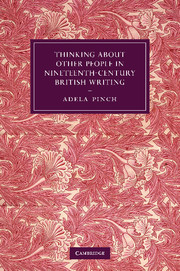Book contents
- Frontmatter
- Contents
- Acknowledgements
- Introduction: Love thinking
- 1 Thinking as action: James Frederick Ferrier's Philosophy of Consciousness
- 2 Foam, aura, or melody: theorizing mental force in Victorian Britain
- 3 Thinking in the second person in nineteenth-century poetry
- 4 Thinking and knowing in Patmore and Meredith
- 5 Daniel Deronda and the omnipotence of thought
- Conclusion: the ethics of belief and the poetics of thinking about another person
- Notes
- Bibliography
- Index
- Cambridge Cultural Social Studies
3 - Thinking in the second person in nineteenth-century poetry
Published online by Cambridge University Press: 05 October 2010
- Frontmatter
- Contents
- Acknowledgements
- Introduction: Love thinking
- 1 Thinking as action: James Frederick Ferrier's Philosophy of Consciousness
- 2 Foam, aura, or melody: theorizing mental force in Victorian Britain
- 3 Thinking in the second person in nineteenth-century poetry
- 4 Thinking and knowing in Patmore and Meredith
- 5 Daniel Deronda and the omnipotence of thought
- Conclusion: the ethics of belief and the poetics of thinking about another person
- Notes
- Bibliography
- Index
- Cambridge Cultural Social Studies
Summary
What does it mean to say to someone, “I am thinking of you”? And what does it mean to write it? Do assertions of this kind betray our kinship, however distant, with the nineteenth-century evangelists of thought-power, believing with them that our thoughts about someone in need are a form of action that can bring restitution, assistance, or at least companionship? Or, is “I am thinking of you” just something we say, a proposition whose substance lies in its performance or communication? If so, does the thinking happen at all?
This chapter argues that nineteenth-century British poetry can provide us with insights into what it means to try to think in the second person, by complicating the difficult questions about what it means to say, and to write, “I think about you.” Paying attention to the poetics of second-person address in nineteenth-century verse may teach us a great deal about how we know what it feels like to think about another person. Studying the poetics of address can demonstrate some of the ways in which what appear to be philosophical problems reveal themselves as literary forms.
That nineteenth-century poetry not only engages with philosophy, but also constitutes itself as a kind of thinking, is a notion that should require no special urging. We can begin by referring to Hegel's Lectures on Aesthetics (1832), which lined up “poetic thinking” with “speculative thinking,” which transcends the limitations of both “ordinary thinking” and “the restricted thinking of the Understanding” which is the work of the “prosaic mind.”
- Type
- Chapter
- Information
- Publisher: Cambridge University PressPrint publication year: 2010



